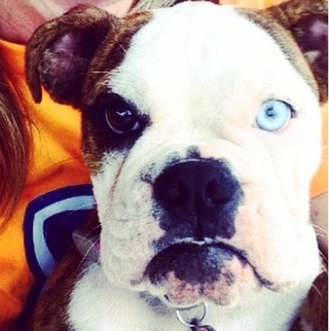- Do you subscribe to Dharma Dog Training’s Newsletter? You should.
- A Unique Campaign from The Humane Society of the United States
- Rabid bats in Omaha- Stay safe, prepared with these tips
- Springtime Activities in Omaha
- Mill Dog Monthly from Bailing Out Benji
- World Spay Day, Legislative Alert in Nebraska
- Attend the Nebraska Rescue Council’s monthly meeting this Saturday
- Five Hard-to-Ignore Reasons to Adopt!
- Paws in Pink to Benefit Breast Cancer Foundation
- VCA, Inc. Acquires MidWest Vet Specialists from Kansas State University
Mouth-to-snout CPR works. Read this story, prepare to save lives!

Animal lovers are finding there’s another way to pamper their pets: learn pet CPR.
Researchers have translated human resuscitation guidelines and training for pet owners, preparing them to use CPR to save their furriest family members.
Veterinarian Daniel J. Fletcher, Ph.D., D.V.M., led the development of the first science-based CPR guidelines for animals, published in 2012 in a special issue of the Journal of Veterinary Emergency and Critical Care. He and 100 other veterinary specialists followed the same formal process used to develophuman CPR guidelines from the American Heart Association, which has funded groundbreaking research in CPR techniques.
Cardiac arrests in dogs and cats are similar to those in children, often resulting from breathing problems rather than heart issues, said Fletcher, professor of veterinary medicine at Cornell University College of Veterinary Medicine in Ithaca, New York.
Choking, allergic reactions and heat stroke are among the top reasons dogs collapse and need CPR. As with children, pets need both rescue breaths and chest compressions.
Terri Taute of Omaha, Nebraska, saved her Maltese BoBo — her husband’s “little princess” — with CPR in 2008. “I knew if I didn’t save her with CPR, I would have had to do CPR on [my husband].”
BoBo had collapsed after being frightened by nearby fireworks on a camping trip. Taute revived her using child and infant CPR training she’d received as an AHA employee.
“I think it’s as important to know pet CPR as it is to know CPR,” Taute said.
AHA CPR instructor Alicia Pederson of Forney, Texas, saved Miri, a Boston terrier-bulldog puppy, in 2014 after finding the newborn “still and cold” in the middle of the night. Within five minutes after starting CPR, Pederson heard a cough, and the puppy started whimpering.
“I thought, ‘Oh my gosh, it worked!’” she said. “You have more of a chance with CPR than without.”
Fletcher said common misconceptions about the effectiveness of animal CPR has held back progress.
There is a longstanding belief in veterinary medicine, he said, that there’s no point in doing CPR because survival rates are so low — currently 6 percent to 7 percent.
But those stats are misleading, Fletcher said. Dogs and cats who go into cardiac arrest shortly after being given general anesthesia have an almost 50 percent chance of survival.
“It’s not hopeless,” he said. “It’s worth being trained.”
Now, it’s just a matter of getting the animal CPR guidelines out to veterinarians and pet owners, said pediatric critical care specialist Vinay Nadkarni, M.D., of The Children’s Hospital of Philadelphia.
In addition, pet CPR training introduces the concepts of human CPR, which could lead more pet owners to learn the technique for people, said Nadkarni, who wrote an editorial in the special issue that featured the pet guidelines.
Using the guidelines, Fletcher developed online training for veterinarians and other veterinary professionals, offered through Cornell. In September, a modified course will be offered online to pet owners.
Interest in pet CPR training has grown since the mid-1990s when CPR instructor Thom Somes founded the pet first aid and CPR training company PetTech. The company now trains about 1,000 people a month and incorporates some of the 2012 recommendations, Somes said.
PetTech instructor Beth Bowers trains pet owners and dog caretakers. The course emphasizes preventing pets from needing CPR in the first place, she said, and includes watch-and-learn techniques and hands-on practice on dog manikins.
“Unfortunately, one of the big reasons people join my class is something happened and they didn’t know what to do,” Bowers said. “It’s an emotional moment, when they realize what they could have done.”
A 2009 Associated Press-Petside.com poll found that nearly two-thirds of dog owners and half of cat owners were at least somewhat willing to perform CPR on their pet.
John Shore of Kansas City, Missouri, considers his white Labrador retriever, Daisy, his daughter. He’d give her CPR “in a heartbeat, so to speak,” he said.
In St. Petersburg, Florida, Suzanne Grant said of her German Spitz, “I wouldn’t think twice about it. Franz is family.”
Thanks to Jamie Schneider, Communications Director- American Heart Association and to American Heart Association News for giving us the opportunity to tell the story.
Related Posts
Latest News
-
What Signs to Look For When My Pet Has a Cold
You have probably heard the expression, “sick as a dog.”...
- Posted 1 week ago
- 0
-
How Often Should I Groom My Pet?
Do you have a grooming ritual for your furry friend?...
- Posted 2 weeks ago
- 0
-
From Kibble to Cuisine: Finding the Perfect Food For Your Pet
Do you ever wonder what the difference is between regular...
- Posted 1 month ago
- 0
-
The Essential Guide to Pet Care: Meeting Your Furry Friends Basic Needs
Are you a first-time pet owner and need to know...
- Posted 1 month ago
- 0
-
Say Cheese! Tips for Keeping Your Pet’s Pearly Whites Clean
Did you know that keeping your dog or cat’s teeth...
- Posted 2 months ago
- 0
-
Feeding Frenzy: How Often Should You Fill Your Pet’s Bowl?
Are you unsure how much food to give your dog...
- Posted 2 months ago
- 0
-
How to Prepare Your Pet for Spring
Winter is in full force, but spring will be here...
- Posted 2 months ago
- 0
























You must be logged in to post a comment Login